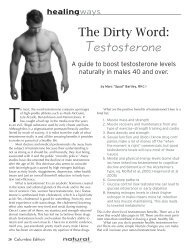February 2013: Bodywork and Relationships - Columbia Natural ...
February 2013: Bodywork and Relationships - Columbia Natural ...
February 2013: Bodywork and Relationships - Columbia Natural ...
Create successful ePaper yourself
Turn your PDF publications into a flip-book with our unique Google optimized e-Paper software.
globalbriefs<br />
News <strong>and</strong> resources to inspire concerned citizens to work together in building a<br />
healthier, stronger society that benefits all.<br />
Safer Cells<br />
Mobile Phones Becoming Less Toxic<br />
The Ecology Center, in Ann Arbor, MI, in conjunction<br />
with technicians at IFixIt.com, has published a list of<br />
toxic chemicals found in 36 cell phones from a<br />
range of manufacturers. The good news is that<br />
companies are responding to consumer <strong>and</strong><br />
regulatory pressure <strong>and</strong> these troublesome<br />
components are on the decline.<br />
The Motorola Citrus, Apple iPhone 4S <strong>and</strong><br />
LE Remarq were the least toxic cell phones in the analysis. Two of the bestselling<br />
models, the iPhone 5 <strong>and</strong> Samsung Galaxy S III, ranked fifth <strong>and</strong> ninth, respectively.<br />
Among earlier models, the 2007 iPhone 2G was found to contain the most toxic<br />
materials.<br />
Jeff Gearhart, research director at the Ecology Center, concludes, “The takeaway<br />
is that mobile phones are chemically intensive <strong>and</strong> full of chemical hazards,<br />
but they’ve been getting a lot better.” The center reported that every phone sampled<br />
in the study contained lead, bromine, chlorine, mercury or cadmium.<br />
Source: Tinyurl.com/MobileRisk.<br />
Parasite Protection<br />
Animals’ Native Remedies Offer Insights<br />
We can learn much from animal species that selfmedicate<br />
naturally. Some have developed the ability<br />
to alter their diets <strong>and</strong> behavior in ways that provide<br />
protection from lethal, microscopic parasites.<br />
Chimpanzees held captive often succumb to infection<br />
by a parasitic worm, which can lead to lethal<br />
intestinal blockages or secondary bacterial infections.<br />
But chimps in the wild rarely experience such deadly<br />
ailments. More than 30 years ago, Michael Huffman,<br />
who studies evolution of social systems at the University<br />
of Kyoto, in Japan, noticed that wild chimps<br />
treated themselves by ingesting foods with special<br />
properties that fight intestinal worm infections.<br />
Scientists recently discovered why monarch<br />
butterflies are so picky in choosing the milkweed plants on which to lay their eggs.<br />
“The females often taste a plant, reject it <strong>and</strong> fly away,” explains Jacobus de Roode,<br />
PhD, of Emory University, in Atlanta, GA. His research team found that butterflies<br />
infected with a certain protozoan parasite seek out milkweeds containing high levels<br />
of cardenolide, a plant steroid that interferes with parasite growth in monarch<br />
caterpillars.<br />
Scientists have identified many other species that partake in self-medicating<br />
practices, including macaques <strong>and</strong> sheep. Recognition that various insects such as<br />
honey bees <strong>and</strong> fruit flies share this trait is enabling scientists to rigorously examine<br />
the phenomenon in the laboratory, with hopes of finding applications in animal<br />
husb<strong>and</strong>ry <strong>and</strong> even human medicine.<br />
Source: The Scientist magazine.<br />
CULTIVATE<br />
NEW<br />
CUSTOMERS<br />
Grow your<br />
business by<br />
advertising<br />
in<br />
Special<br />
Food & Garden<br />
March Issue<br />
Contact Us:<br />
803.233.3693<br />
HealthyLiving<strong>Columbia</strong>.com<br />
<strong>February</strong> <strong>2013</strong><br />
11







